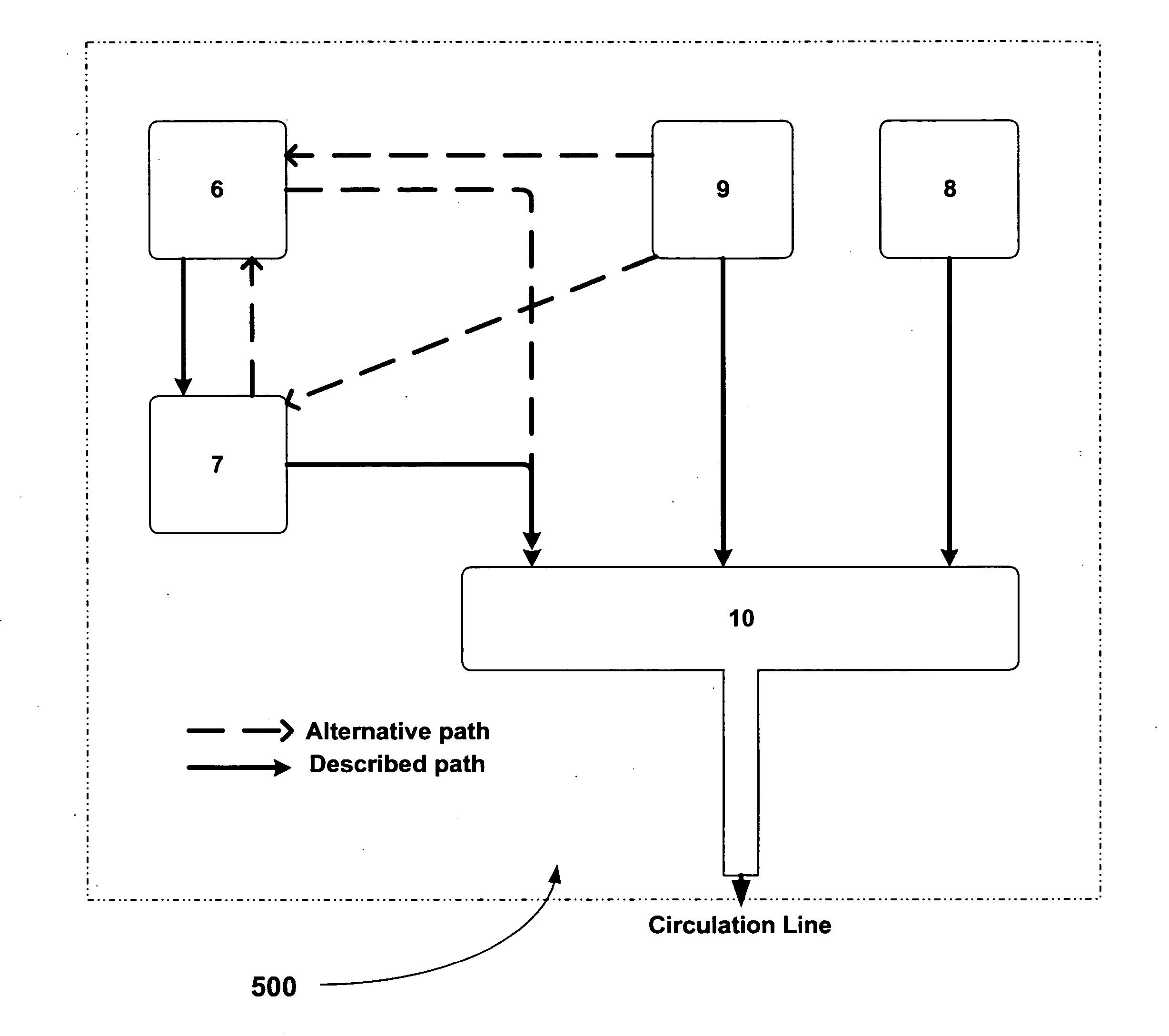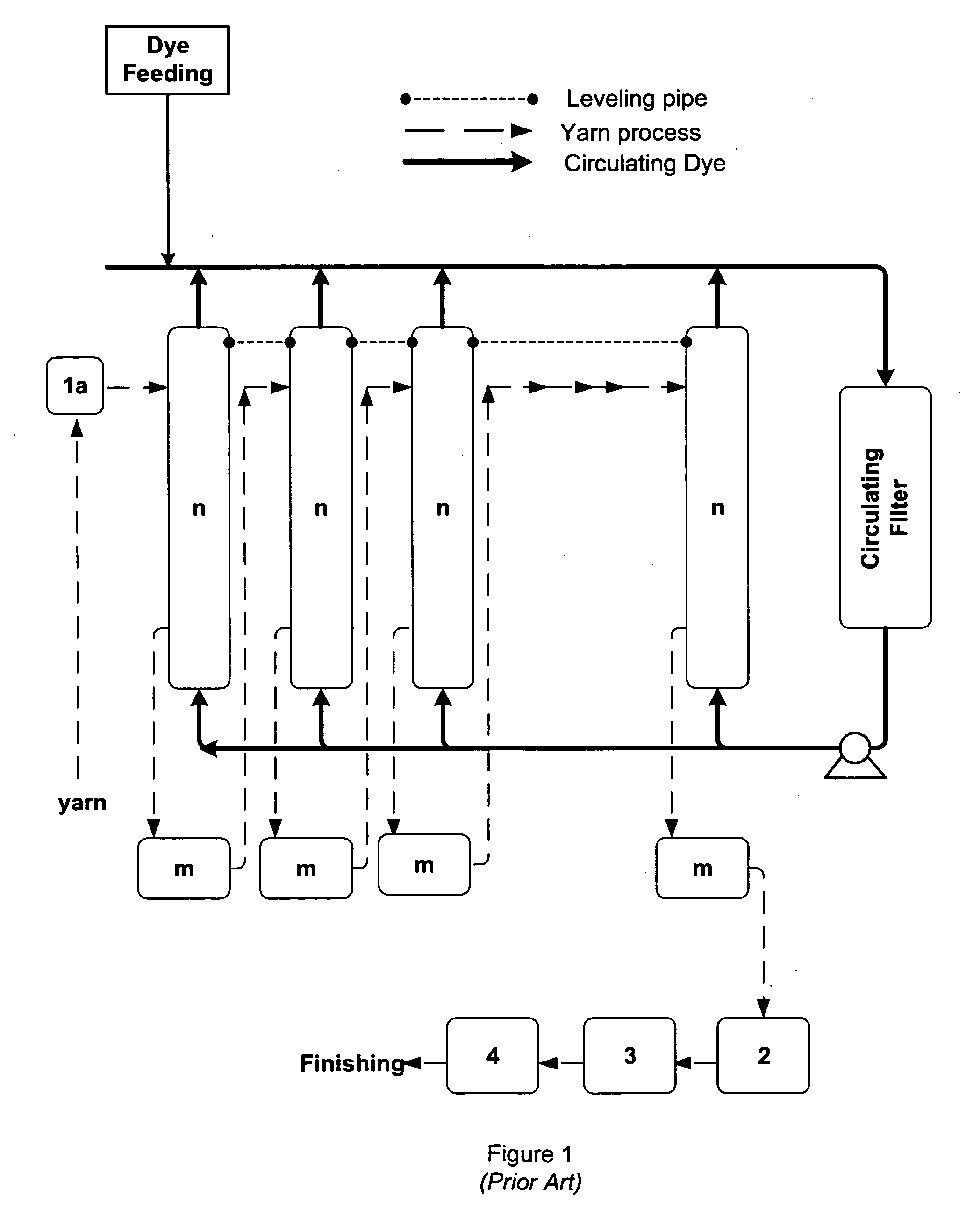Process for introducing vat dyes and chemicals into textiles
a technology of vat dyes and chemicals, applied in the dyeing process, sulfur dyes, chemistry apparatuses and processes, etc., can solve the problems of natural worn-out or washout effect, no reduced stock solution is available in the market, and precipitation, etc., and achieve the effect of reducing dyes efficiently
- Summary
- Abstract
- Description
- Claims
- Application Information
AI Technical Summary
Benefits of technology
Problems solved by technology
Method used
Image
Examples
example 1
[0046] Cotton yarn dyed with darker shades of Vat Red 10 (C.I. 67000):
[0047] Anthraquinonoid vat dye was used in pilot plant operation using treatment unit of the present invention in conjunction with rope-dyeing process.
[0048] Feeding Preparation:
[0049] Dye Composition in Dye Tank
[0050] The dye composition in the dye tank was made in the following order. A solution 5 g / l of dispersing agent (Setamol WS, commercially available) was made. Next, complexing agent (Trilon TB) was added to a final concentration of 2 g / l. Next, Vat Red 10 (C.I. 67000) was added to the solution to make a final concentration of 150 g / l of dye. Finally, the wetting agent was added to the solution to a final concentration of 3 g / l. This composition was introduced to the reaction unit at a rate of 0.10 l / min.
[0051] Caustic Feeding
[0052] Caustic composition of the additive tank was made as follows. Prepared 40 Be caustic solution (494 g / l of sodium hydroxide) with 47 Be caustic (668 g / l sodium hydroxide, ...
example 2
[0061] Higher Indanthren Direct Black 5589 concentrations in the treatment unit yields higher dyeing performance.
[0062] Equipment
[0063] Spectral reflectance measurements for estimation of color strength were done with Datacolor Spectroflash SF600. Concentrations measurements were made with Metrohm Titroprocessor 726, Dosimat 685 and Stirrer 728 by red-ox titration method. Relative dye concentration (herein after C*) is defined as dye concentration (hereinafter C) divided by factor k, where k is defined as the ratio of formula weight of Indathren Direct Black 5589 (hereinafter FWb) divided by formula weight of Indigo (hereinafter FWi).
C*=C / k
[0064] (where k=FWb / Fwi)
[0065] Solution Preparation
[0066] C=3 g / l
[0067] 0.75 g Indanthren Direct Black 5589
[0068] 2.75 ml Caustic soda (48%)
[0069] 1.13 g Hydrosulphite
[0070] 250 ml volume solution is prepared by adding these chemicals to distilled water. 10 ml of this solution was fed used for solubility measurement.
[0071] C=30 g / l
[007...
PUM
| Property | Measurement | Unit |
|---|---|---|
| temperature | aaaaa | aaaaa |
| temperature | aaaaa | aaaaa |
| concentration | aaaaa | aaaaa |
Abstract
Description
Claims
Application Information
 Login to View More
Login to View More - R&D
- Intellectual Property
- Life Sciences
- Materials
- Tech Scout
- Unparalleled Data Quality
- Higher Quality Content
- 60% Fewer Hallucinations
Browse by: Latest US Patents, China's latest patents, Technical Efficacy Thesaurus, Application Domain, Technology Topic, Popular Technical Reports.
© 2025 PatSnap. All rights reserved.Legal|Privacy policy|Modern Slavery Act Transparency Statement|Sitemap|About US| Contact US: help@patsnap.com



